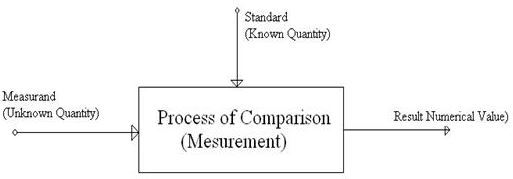The measurement of a given quantity is essentially an act or result of comparison between a quantity, whose magnitude (amount) is unknown with a similar quantity whose magnitude (amount) is known, the latter being called standard.

Measurement involves the use of the instrument as a physical means of determining quantities or variables. The instruments serve as an extension of human faculties and enable the man to determine the value of unknown quantity or variable which with unaided faculties cannot measure.
The instrument consist of a single unit which gives an output reading or signal according to the unknown variable (measurand) applied to it. In more complex measuring situation a measuring instrument may consist of several separate elements. These elements may consist of a transducing element which converts the measurand to an analogous form the analogous signal is then processed by some intermediate means and then fed to the end device to present the results of the measurement for the purpose of display, record and control. Because of this modular nature of the elements within it, it is common to refer the measuring instrument as a measuring system.
Functions of Instruments and Measurement Systems
Instruments or measurement system are classified based upon the function they performed.
1. Indicating Function: Different kinds of methods for supplying information concerning the variable quantity under measurement.
2 Recording Function: Stores or write the value of a quantity under measurement.
3. Controlling Function: In this case, the information is used by the instrument or the system to control the original measured.
Application of Measurement Systems
1. Monitoring of process and operation- simply indicating the value or condition of the parameter under study. For example- water and electricity meter.
2. Control of process and operations- automatic control system a very strong association between measurement and control for example -refrigeration with thermostatic control.
3. Experimental Engineering analysis: engineering problem, theoretical and experimental methods may be used depending upon the nature of the problem.
Excercise
Q. What is Measurement?
Ans. Measurement is defined as an act or the result of comparison between the unknown quantity and a predefined standard.
A measurement of any quantity is characterized by a numerical value followed the unit. The numerical value is meaningless if it is not followed by the unit. For example, if you measure a length of the table, it comes out to be 2.5 metre. Then, only numerical value 2.5 is meaningless without the unit of length metre.
Q. What are the basic requirements for meaningful measurement results?
Ans. The standard used for comparison purposes must be accurately defined and the method adopted for measurement must be provable.
Q. What are the methods of measurements?
Ans. There are two types of methods of measurements i.e.
1. Direct Methods
Direct measurement refers to measuring exactly the thing that you are looking to measure. So, the unknown quantity or measurand is directly compared against a standard. For example pressure, time, length, weight, etc. can be directly measured.
2. Indirect Methods
Indirect measurement refers to measuring something by measuring something else. Sometimes it is not possible to measure a quantity directly. Hence we measure a different quantity that can be easily measured and using which we can find actual measurand. For example, differential pressure on a pitot tube is used to determine airspeed.
Q. What are instruments?
Answer. An instrument is a device that communicates, detects, denotes, indicates, observes, measures, records, or signals a quantity or controls or phenomenon, or manipulates another device.
Q. What are deflection and null type instruments?
Answer. In Null Type Instruments, the pointer is maintained at a fixed position and measurement is done by balancing.
In Deflection Type Instruments, the pointer of the electrical measuring instrument deflects to measure the quantity.
Q. What are the function of instrument and measurement systems?
Answer.
1. Indicating function
2. Recording function
3. Controlling function
Q. What are the applications of measurement systems?
Answer.
1. Monitoring of process and operation- simply indicating the value or condition of the parameter under study. For example- water and electricity meter.
2. Control of process and operations- automatic control system a very strong association between measurement and control for example -refrigeration with thermostatic control.
3. Experimental Engineering analysis: engineering problem, theoretical and experimental methods may be used depending upon the nature of the problem.
Q. What is the difference between information and signal?
Answer. Information is the data or details relating to an object or event while signal carries the information about magnitude or time relating to an object or event.

Thank you ,share about measurement system